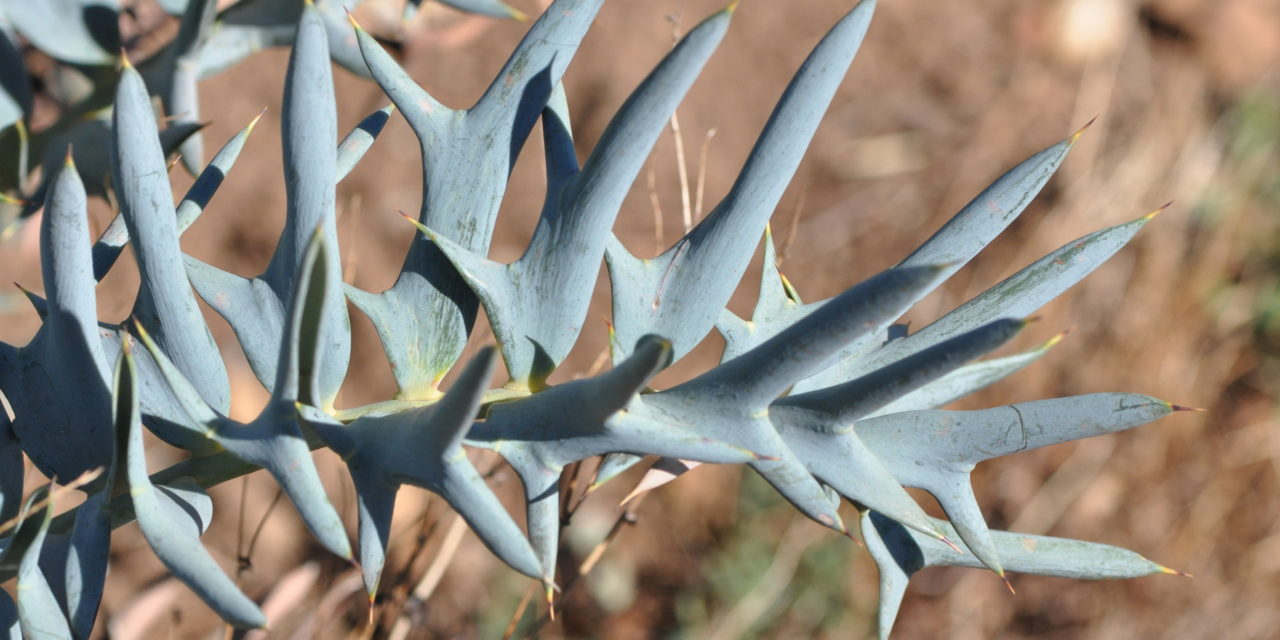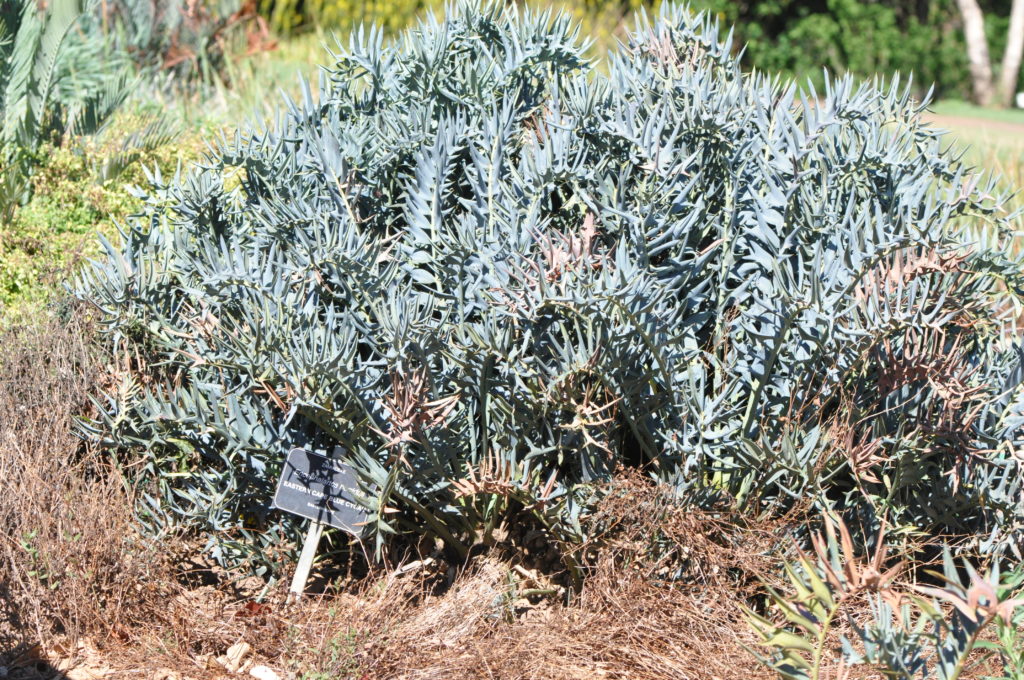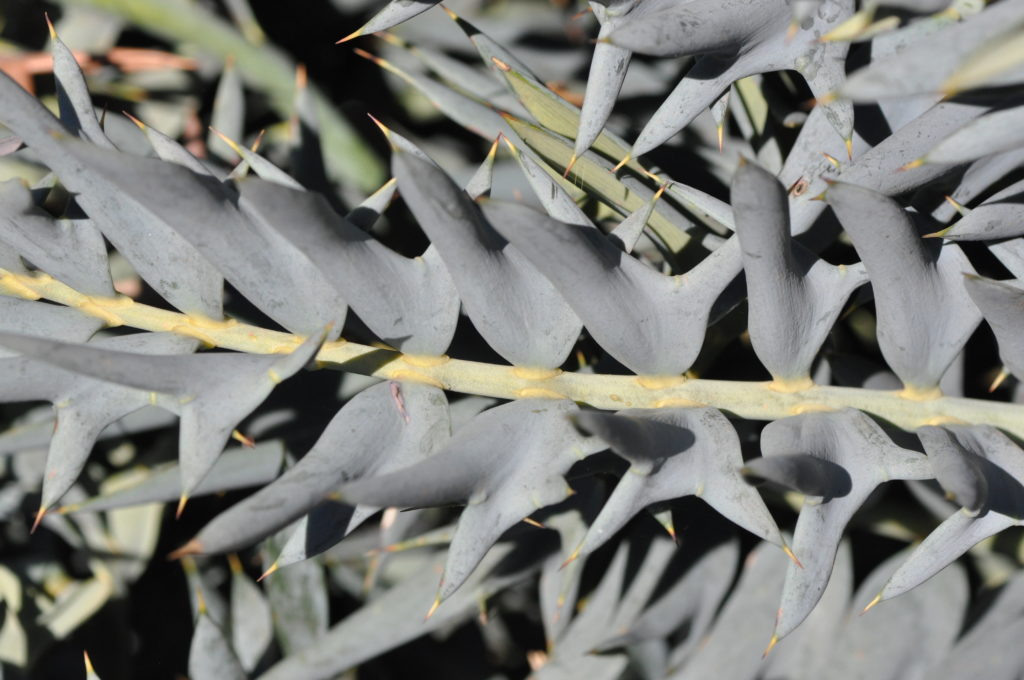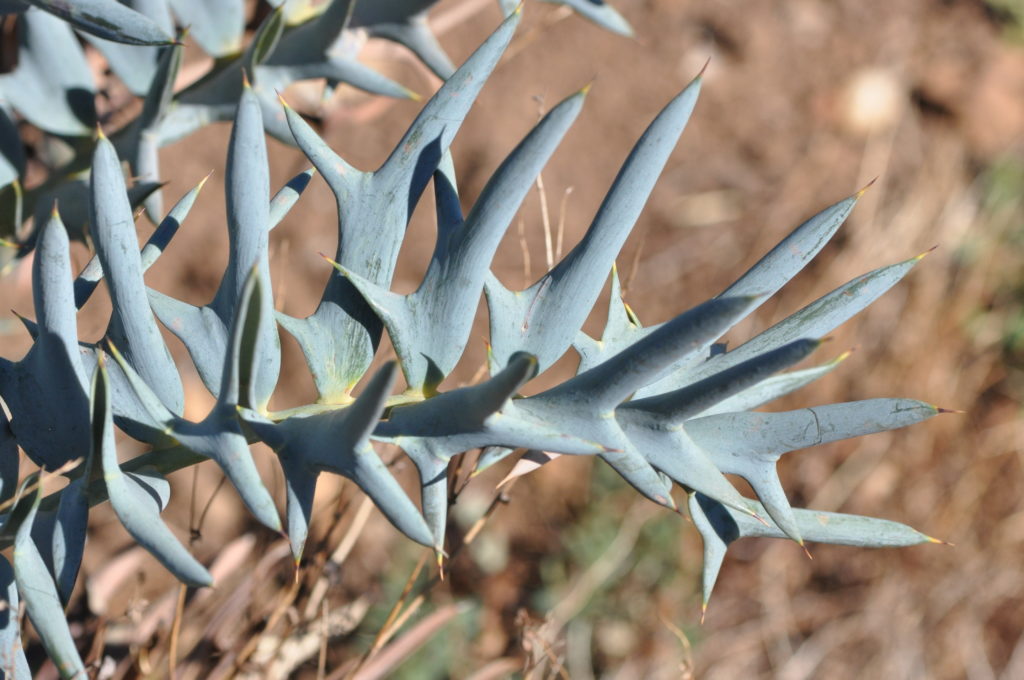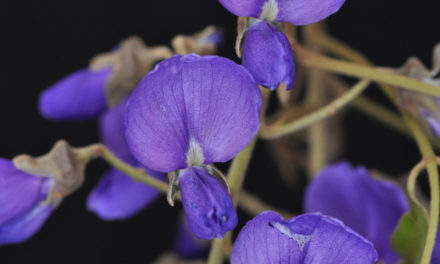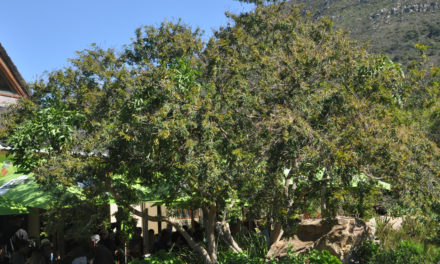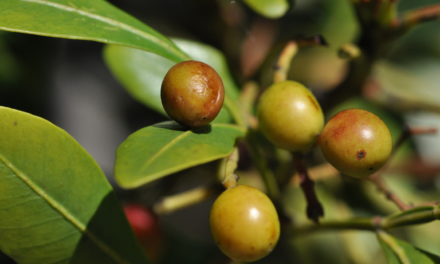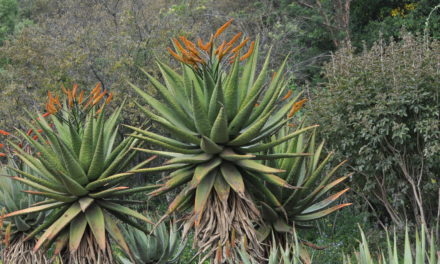General Info – summary
The dioecious Plant to 1m high & trunk to 30cm wide. Many stems may be present. Distinctive Leaves are pinnately compound & leaflets lack midribs. Broad, blueish leaflet lobes are stiff, twisted and very spiny. The leaf base is not reduced to prickles. Cones – 1 male (with motile sperm) and 1 ovate female cone with naked ovules. Poisonous Seeds + a fleshy covering are released when the female cone disintegrates.
Description
Encephalartos horridus
Previous Names: Nil.
SA Tree No. n/a.
Common names: Blue Cycad, Eastern Cape Blue Cycad.
Comparing Gymnosperms (G) and Angiosperms (A). G and A are both Spermatophytes (seeds producers). G seeds are naked (unenclosed), lack flowers (have no ovaries or fruit). In A, seeds develop in flower ovaries. After fertilization, the ovule (egg) becomes a seed, and fruit surrounds the ovaries. In G seeds are usually in cones and become visible when mature cones open. Both G and A have vascular tissue: xylem (water conducting – from roots) and phloem (products of photosynthesis from leaves to the plant). There are far less living species in G (1 000+) than in A (300 000+). G are mainly woody trees and shrubs and only 1 sp. has climbing vines. In A there are many herbs, climbing vines and trees. Conifers (including pines) are the largest group of G
Family: Zamiaceae. This family is part of the major group: Gymnosperms. They are usually cone-bearing plants producing naked seeds and include Ginkgo (in China), Cycads, Conifers (e.g., pine trees) and Gnetophytes: e.g., the unique Welwitschia mirabilis (tweeblaarkanniedood) are not wind pollinated and found in the deserts of western Namibia and southern Angola. Members of the gymnosperm family Zamiaceae have no flowers or fruit and the seeds are often contained in Cones. This family has 8 genera, including the Genus Encephalartos, which contains all species of cycads).
Name derivation: Those cycads, native to Africa are all contained within the genus Encephalartos – within-head-bread: referring to the starchy bread that can be made from the pith of the inner trunk. horridus – Latin for rough or bristly – referring to the spiny, stiff leaflets. This species is similar to E. trispinosus. Hybrid plants do occur. All cycads fall in the genus Encephalartos. Species of Encephalartos (Cycads) are only superficially palm or fern like and are usually unbranched. The African plants in the genus Encephalartos include about 66 species and 35+ species occur in southern Africa.
Conservation: National Status: E N Endangered. 2009. Assessor (J.S. Donaldson). This is because of illegal harvesting and habitat loss e.g. through urban expansion. More than half of these trees have now been lost in the Port Elizabeth and Uitenhage area. The population trend is decreasing. Recently, far more nurseries are selling this plant and this should help stabilise this cycad.
Plant
The initial Stem (main axis of the plant, the leaf and flower bearing as distinguished from the root-bearing axis) may branch freely and is up to 1m high and 30cm wide. The stem continues below ground and this part is usually longer than the part above ground. Many stems may be grouped together forming an overlapping mass of impenetrable stems and leaves (photo below). The shallower the soil, the more above the soil the trunk extends. The tree has tuberous roots, which replace the taproot. Plants may become extremely old.
- Photo: David Becking.
Leaves
The Leaves are pinnately compound (leaflets arranged along either side of the leaf rachis, the central stalk, like a feather). They have thick, hard, highly twisted Leaflets – each up to 10 x 3cm. The colour can vary – young leaves are initially silvery blue and become greener with time. These broad leaflets are a distinct and variable blue-grey-green and have 2-3 long lobes that end in very sharp spines. One or more of these spines are orientated in a different plane to the remainder. The leaflets bend backwards and collectively these characteristics make this a unique, distinct and menacing sight. Unlike other members of the family Zamiaceae, the cycads have leaflets that lack a central Midrib (photo 67). The collective leafy diameter of the plant may reach close on 2m. Generally, the more direct the sunlight the shorter the diameter and the waxier the leaves. In the dwarf form, the stem and leaf size are smaller. Unlike many cycads, the leaflets of this plant are not reduced to prickles at the base at the leaf. The Petiole (leaf stalk) is up to 15cm long. Petiolules (bases of leaflets) are absent. Older leaves tend to lie down close to the ground. The hard leaflets do not bend easily, and the sunken veins are parallel but difficult to see (photo 67). Stomata (structure utilising 2 guard cells that, unlike lenticels, can control gaseous exchange) are present but a microscope is necessary to view them).
- Photo: 67 David Becking.
- Photo 68: David Becking.
Cones
All Gymnosperms have unenclosed or naked seeds. They have no flowers or fruit, and the seeds are often contained in cones. In the Angiosperms (flowering plants), the seeds are enclosed in an ovary. In the Gymnosperms, there are 2 modes of fertilization. In all the Cycads (including Encephalartos) and the single extant (not extinct) species of Ginkgo (Ginkgo biloba), the Male cones produce motile sperms. Whereas the remaining members of the Gymnosperms all have non-motile sperm with no flagella and are moved along with a pollen tube to the egg.
This plant is Dioecious (having male and female cones on separate plants). These cones develop in the centre of the leaf whorls. Usually, 1 but occasionally 2 Male Cones are formed. They are distinctly bluish green. The narrower, almost cylindrical male cones and slighter wider at the middle and taper towards both ends. They are hairy when young, making the cone darker until the hairs fall. The male cones are up to 40 x 12cm and produce motile sperm. The single, ovate (egg-shaped) Female cone is up to 38 x 20cm and has rigid scales. Here Ovules (eggs) are naked. Pollination agents are insects. The ovate (egg shaped) Female cones remain visible and wider – up to 40 x 20cm than the male cones. At maturity, Seeds are released when the Female cones disintegrate. Seeds are up to 3,5cm long and 2,5cm wide. Birds, monkeys and baboons disperse the seeds. They eat the fleshy outer covering and leave behind the poisonous seed. (Dec-Jan).
Distribution & Ecology
This plant grows in dry thickets and close to rocky outcrops, in places usually receiving between 25 and 60cm rainfall per year (summer and winter). Here they are subjected to temperatures of up to 40°C. They can also tolerate mild frost. This tree are Endemic (Endemism is the ecological state of a species being unique to a defined geographic location) in South Africa. They often occur on rocky quartzite outcrops (quartzite – composed almost entirely of quartz. It is non-foliated and usually forms from the metamorphism of sandstone). These plants occur naturally in the Eastern Cape (Port Elizabeth to Uitenhage) where frosts are not an annual event. Cycads have Coralloid Roots that contain symbiotic cyanobacteria (blue-green algae) that fix atmospheric nitrogen. Through a process of complex biological pathways, the cyanobacteria convert atmospheric molecular nitrogen into compounds such as ammonia, and amino acids needed by cycads. Problems that this plant face include snout beetles (weevils with a downward curving snout) and some moth larvae.
Ethnobotany
Propagation is by seeds or suckers. It is important to remember that the Seeds are poisonous and should be handled with gloves. All cycad seeds are carcinogenic and contain neurotoxic glycosides (cycasins). These are poisonous to mammals. Plant seeds in full sunlight, in well-drained soil. They should not be over-watered. The Suckers form at the base of the stem. Note: these suckers will be the same sex as the parent plant and this is significant because both sexes are necessary for future seed production. Suckers are the best way to ensure this. Seedlings are slow growing. This cycad can grow to form an impenetrable barrier.
References
Coates Palgrave, M. 2002. Keith Coates Palgrave Trees of Southern Africa. edn 3. Struik, Cape Town.
Donaldson, J.S. 2009. Encephalartos horridus (Jacq.) Lehm. National Assessment: Red List of South African Plants version 2020.1. Accessed on 2023/04/05.
https://en.wikipedia.org/wiki/Encephalartos_horridus
http://cycadsociety.org/?page_id=1794
http://biodiversityadvisor.sanbi.org/wp-content/uploads/sanbi-identify-it/plants/encephalartos.htm
http://www.theplantlist.org/browse/G/Zamiaceae/
https://www.diffen.com/difference/Angiosperms_vs_Gymnosperms
http://cycadsociety.org/?page_id=1794

